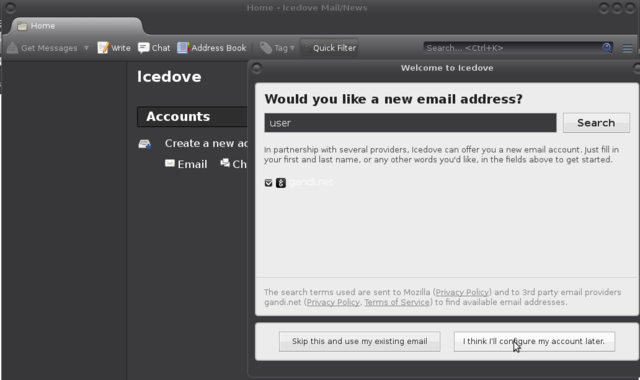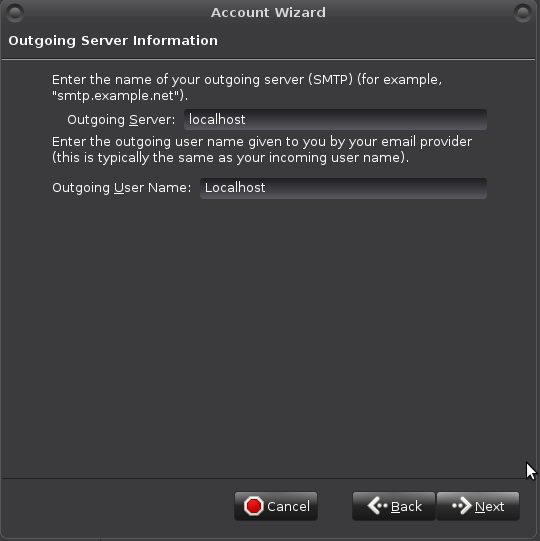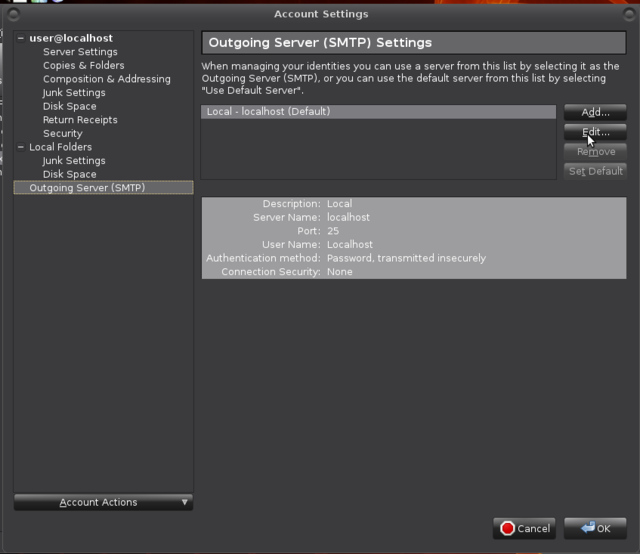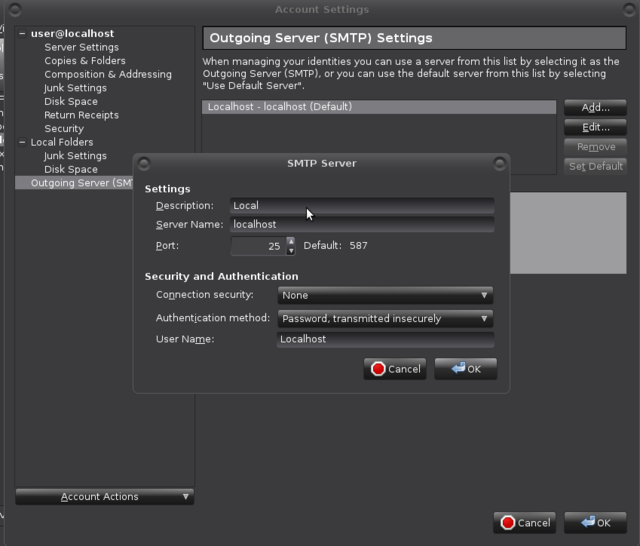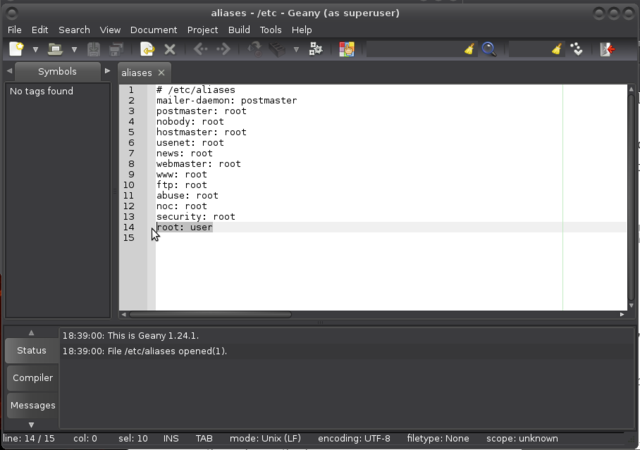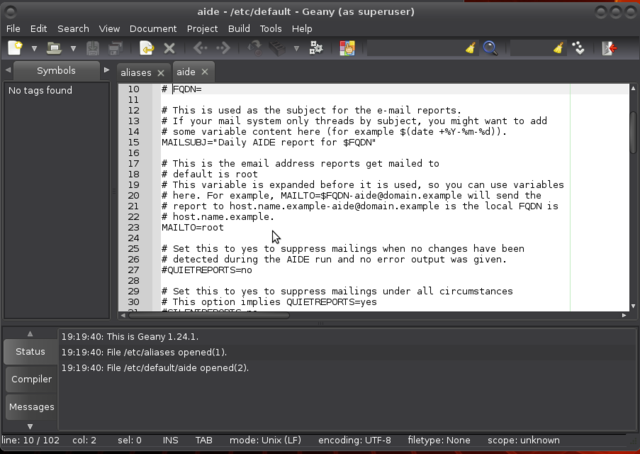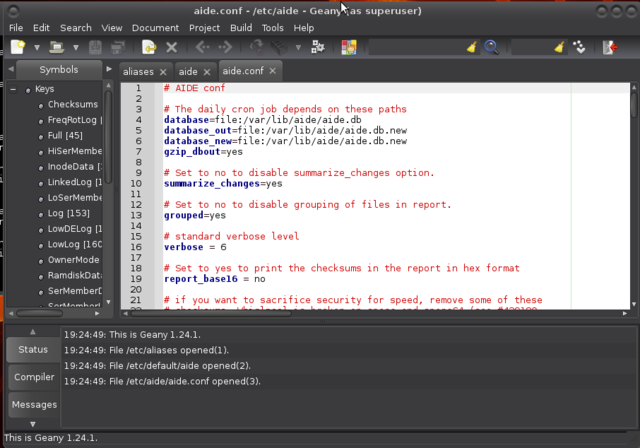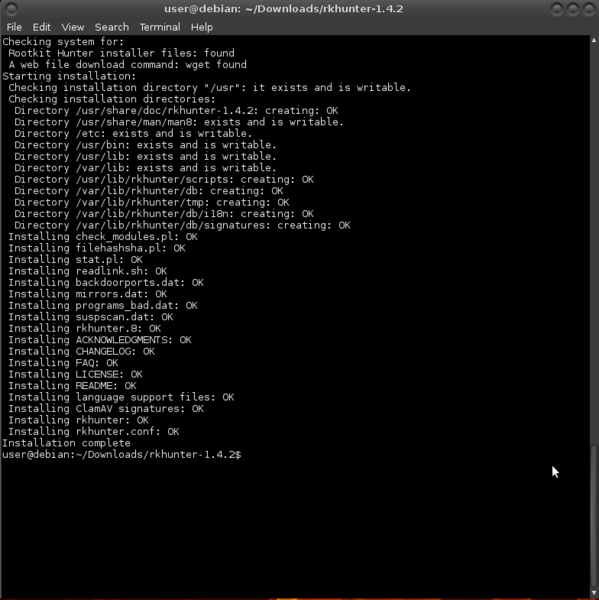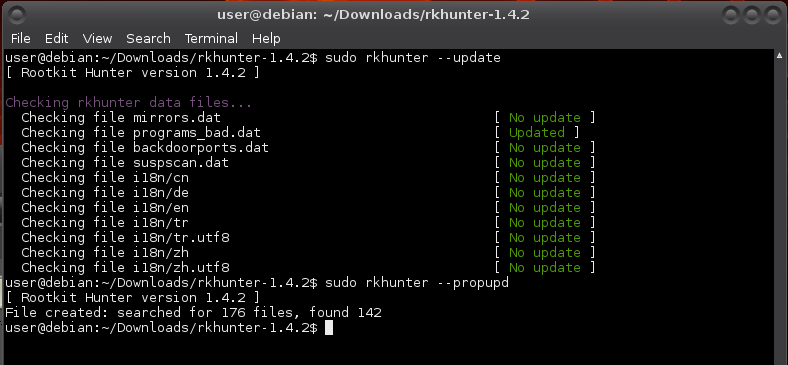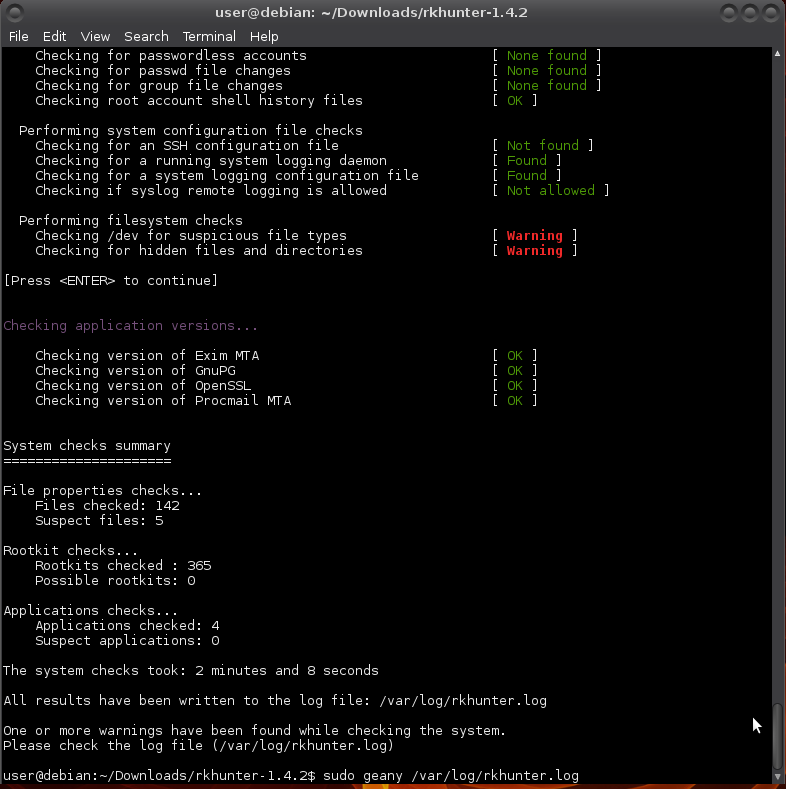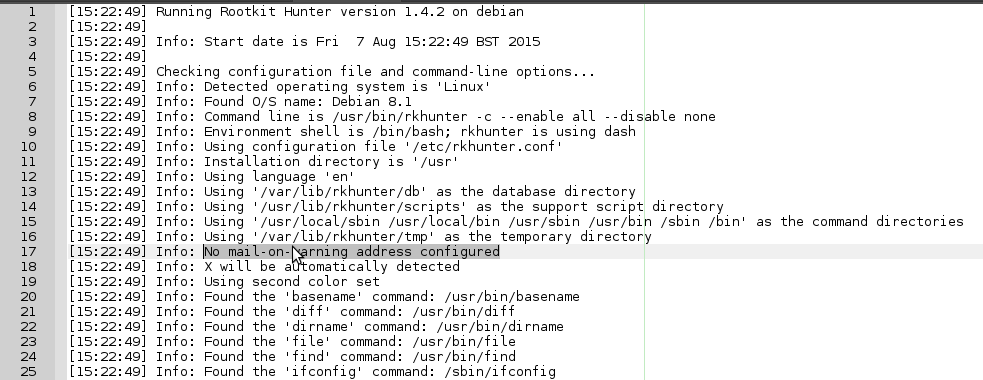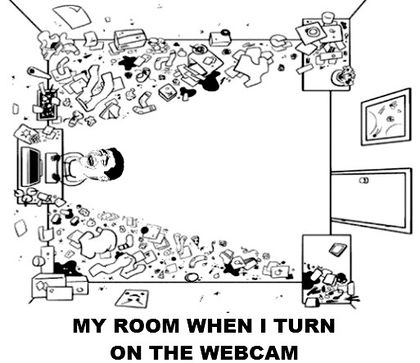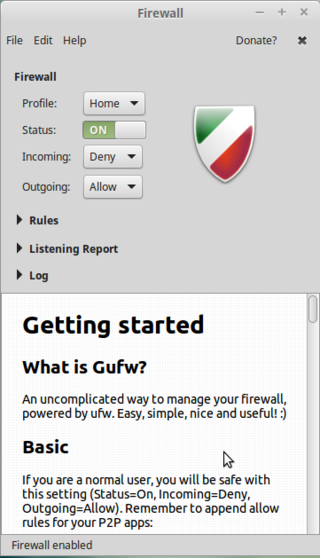Linux security
From Gender and Tech Resources
This page contains some basic security measures specifically for people getting started with linux. Knowing your way around a bit on the kinky linux command-line helps. If you run into trouble, find us on IRC.
Contents
- 1 Setting up root mail
- 2 Installing intrusion detection
- 3 Installing rootkit scanners
- 4 Managing passwords
- 5 Turning camera off
- 6 Turning microphone off
- 7 Using a firewall
- 8 Safer browsing
- 9 Using removable storage media
- 10 Encryption
- 11 Making backups
- 12 Traffic monitoring
- 13 Configure sysctl (*)
- 14 Audit your setup
- 15 Resources
- 16 Related
Setting up root mail
Debian with MATE comes with the exim mailserver installed. If you don't like exim, install postfix (if you install the one, the other is uninstalled).
- Exim uses the Sendmail design model where a single binary controls all the facilities of the MTA. This monolithic design is inherently less secure due to the lack of binary separation between the individual components of the system. Exim separates processes and has well-defined stages where it gains or loses privileges.
- Postfix has a modular design to improve security over Qmail. A master daemon (a background process) launches other smaller processes with limited privileges that do specific tasks related to the various stages of mail delivery. The modular approach limits the effects of attacks.
- Sendmail is the default MTA shipped with many Linux distribution sets and is the most well-known. It is easy to configure but had the most security loopholes, partly because it was designed long before hackers started attacking email systems. Developers fix most security issues quickly, but because it has the most number of users, it is still the biggest target for hackers.
Postfix
Installing
To install postfix:
$ sudo apt-get install postfix
Setting up local email account
Next is setting up an account in a mail client.
icedove
The wizard of icedove (thunderbird) does not allow directly for setting up local mail adresses. Choose "I think I'll configure my account later.":
Make the menu appear, and choose the big Movemail link (all the way to the right of the blue email):
Fill in "Identity" data like so:
Outgoing Server Information like so (will be revisited):
Your "Account Name":
If all went well the account has appeared. Revisit SMTP settings: Edit > Account Settings -> Outgoing Server (SMTP) -> Edit
Set Port 25:
You may already have messages for user. Maybe not for root yet.
Open /etc/aliases with your favourite editor (vi, vim, nano, geany):
$ sudo geany /etc/aliases
And make sure there is a root: username, username being *your* username of course, and a postmaster: root line in the file.
Installing intrusion detection
You can use a firewall, keep your system softwares up to date, stop all unrequired services, use long and difficult passwords and password managers, and more (see below), there is still a chance that some intruder might get into your system.
When intruders penetrate your system there is a great chance that they will want to make their presence as quiet as possible. To do so, they are most likely to replace some common binaries such as ls, netstat or ps with versions that will not make their presence visible. For example, ls can be replaced with an ls version that won't show the files they created, netstat will not show connections that are used by the intruder, and ps will hide processes the intruder runs. To detect changes like that in your system, you can set up intrusion detection with for example aide or tripwire.
Aide and tripwire are both File Integrity Agents (FIAs). A FIA monitors the integrity and state of the files and objects on your machine. If it detects changes to those files, then it alerts the administrator that an unauthorised access or change has taken place. FIAs usually take a hash of all files to be monitored using an algorithm like MD5. The snapshot is periodically checked against the current hash of the file and any variations alerted on.
For some "aide vs tripwire" notes, see Linux applications: Intrusion detection, and for an example install of tripwire on a server, see Linux server security: Installing intrusion detection. On a home system, aide.
aide
Installing
To install aide on a debian based system:
$ sudo apt-get install aide
Open up /etc/default/aide with your favourite editor to change who to send its reports to:
$ sudo geany /etc/default/aide
Initialising
Initialise (this can take some time):
$ sudo aideinit
Configuring
Most of aide configuration can be found in /etc/aide/aide.conf. This file is pretty well documented and default rules are quite decent. Aide aims at reporting files that changed since the last snapshot (stored in /var/lib/aide/aide.db). In hostile environments, a good security measure is to keep the database file on a floppy disk, cdrom or external disk. If you have such a device, you can copy the current snapshot to it and use the snapshot from that device during later runs of aide.
Before making modifications to the configuration file, make a backup first:
$ sudo cp /etc/aide/aide.conf /etc/aide/aide.conf.old
So let say that you have a copy of aide.db on an external disk. To use that snapshot, you can change database=file:/var/lib/aide/aide.db to database=file:/media/user/drive/aide/aide.db:
Read through the file to acquaint yourself with aide. By default, changes in Binaries and Libraries directories are checked. Those are matched to the BinLib rule, which basically checks for any changes in permissions, ownership, modification, access and creation date, size change, md5 and sha1 signature, inode, number of links and block count. Then, it also checks for modifications in the log files against the rule Logs. Because log files tend to grow, you cannot use a signature there and you also have to ask aide not to check for size modification (S).
Usage
On debian alikes, aide is run on a daily basis through the script /etc/cron.daily/aide. Default settings in /etc/default/aide tells aide to update it's database. Using database_out value in /etc/aide/aide.conf, aide is going to output a new database any time it runs in /var/lib/aide/aide.db.new if you kept the default settings.
Any time you install new packages or change some configuration settings, run:
$ sudo /etc/cron.daily/aide
And check in the report that any modifications were only done to files you intended to modify and that added files are only coming from packages you have just installed and copy the new database to whatever place your database points to. Great way to learn about linux and non-intended changes too.
Installing rootkit scanners
A rootkit is a collection of tools a hacker installs on a victim's computer after gaining initial access. It generally consists of network sniffers, log-cleaning scripts, and trojaned replacements of core system utilities such as ps, netstat, ifconfig, and killall. Most times they are self-hiding toolkits to avoid the eye of the sysadmin. Applications that are used to detect rootkits are known as rootkit scanners. There are two rootkit scanners that are important to have on your linux box: rkhunter and chkrootkit. Both.
rkhunter
Rootkit Hunter (rkhunter) is a shell script to detect known rootkits or malware. It also performs checks to see if commands have been modified, and various checks on the network interfaces, including checks for listening applications.
Installing
You can install it from the Software Center or synaptic, or from the commandline:
$ sudo apt-get install rkhunter
Or you can get get it from http://sourceforge.net/projects/rkhunter/ or check current version number and use wget:
$ wget http://downloads.sourceforge.net/project/rkhunter/rkhunter/1.4.2/rkhunter-1.4.2.tar.gz
After download, extract the files and enter the resulting directory:
$ tar xzvf rkhunter* $ cd rkhunter*
Run the install script:
$ sudo ./installer.sh --layout /usr --install
Updating database
Update the rkhunter database:
$ sudo rkhunter --update
This command has to be run on a regular basis to keep the database of known rootkits current. You can use cron to schedule running of this command at regular intervals. See Running jobs, jobs, jobs! for more on running commands or scripts at a given date and time.
Baselining
Set baseline file properties by checking the current values and storing them as known-good values:
$ sudo rkhunter --propupd
rkhunter is configured to be generic and each distro can (and most do) diverge from expected defaults. These appear during an initial run as false positives:
$ sudo rkhunter -c --enable all --disable none
You'll get groups of results, warnings, and at the end a summary of the results.
You can have a look at more details of the warnings in /var/log/rkhunter.log.
$ sudo geany /var/log/rkhunter.log
I immediately encounter these noticeable two:
Sometimes if you change something, more warnings vanish or appear, so I always work on a few unrelated ones, then run --propupd and rkhunter -c again as shown above, until I no longer have warnings. Open up rkhunter's configuration file:
$ sudo geany /etc/rkhunter.conf
Remove the # in front of MAIL-ON-WARNING and replace the fake email adresses with your local mail account (see above):
Likewise set the package manager:
I am also getting warnings from the deleted_files test:
No problem. Mate and iceweasel need to be able to use tmp files. You can make the strings to allow processes using deleted files for in /etc/rkhunter.conf (on debian-based):
$ sudo awk '/Process: / {print "ALLOWPROCDELFILE="$3}' /var/log/rkhunter.log | sort -u
[sudo] password for user:
ALLOWPROCDELFILE=/usr/bin/mate-terminal
ALLOWPROCDELFILE=/usr/lib/iceweasel/iceweasel
Select and copy/paste the strings to the /etc/rkhunter.conf file (right-click mouse will give you the option to copy from command-line):
And a warning from the packet_cap_apps test:
Get the strings for allowing (current) packet capturing applications:
$ sudo awk -F"'" '/is listening on the network/ {print "ALLOWPROCLISTEN="$2}' /var/log/rkhunter.log
[sudo] password for user:
ALLOWPROCLISTEN=/sbin/dhclient
and I only needed to comment it out:
A few suspicious files and a hidden dir from the filesystem test:
/dev/shm is an implementation of traditional shared memory concept for passing data between programs. One program will create a memory portion, which other processes (if permitted) can access. Like a tmp file. A performance choice. /dev/shm/pulse-shm-0123456789 or whatever number seems not dangerous for the system. It's a clean install, and I'll whitelist it.
If I were to just add a line ALLOWDEVFILE=/dev/shm/pulse-shm-0123456789 to the rkhunter configuration file, this will stop the warning. Until I reboot. The numbers in the end of pulse-shm files change on every start and is unpredictable. This is where regular expressions and wildcards come in handy. As it is, it only needs commenting out:
The presence of the hidden /etc/.java directory also gives me a warning. So often do /dev/.udev, /dev/.static and /dev/.initramfs. These are known hidden (sofar) non-malignent hidden directories and can simply be whitelisted (only needs commenting out):
ALL GREEN. Purrrrfect baseline. For now. :) In the near future more applications may try to use deleted files, and after installation of applications more warnings may appear.
unhide
ACTUALLY, nearly all green and two purple:
-
unhide(ps) is for detecting hidden processes and implements six techniques:- Compare
/procvs/bin/psoutput - Compare info gathered from
/bin/pswith info gathered by walking through the procfs. - Compare info gathered from
/bin/pswith info gathered from syscalls (syscall scanning). - Full PIDs space occupation (PIDs bruteforcing)
- Reverse search, verify that all thread seen by
psare also seen by the kernel (/bin/psoutput vs/proc, procfs walking and syscall) - Quick compare
/proc, procfs walking and syscall vs/bin/psoutput.
- Compare
-
unhide-tcpis a forensic tool that identifies TCP/UDP ports that are listening but are not listed in /bin/netstat through brute forcing of all TCP/UDP ports available. It comes with unhide.
$ sudo apt-get install unhide
$ sudo rkhunter --propupd
$ sudo rkhunter -c --enable all --disable none
Now it's all green. :)
chkrootkit
chkrootkit is a shell script that checks system binaries for rootkit modification.
Installing
To install chkrootkit:
$ sudo apt-get install chkrootkit
Configuring
If you want an automatic daily run of chkrootkit, open /etc/chkrootkit.conf and replace RUN_DAILY="false" with RUN_DAILY="true"
$ sudo geany /etc/chkrootkit.conf
Usage
Using chkrootkit (perform all tests):
$ sudo chkrootkit
Managing passwords
Using a password manager allows you to load passwords in your clipboard, making it hard to catch it with a keylogger (just in case). And all good password managers allow you to generate passwords, making the passwords independent from your personal preferences and harder to crack. One of the easiest password managers is a GUI tool called keepassx:
$ sudo apt-get install keepassx
It will appear in your menu. A "first steps" tutorial can be found here http://keepass.info/help/base/firststeps.html
Recommendations:
- Keep the database on a removable medium like an encrypted USB stick.
- Use a second encrypted stick to keep a backup of that database on.
- For added security, set up the database to use a password as well as a keyfile.
- Try to always close off the application. It uses a lockfile to prevent access by other processes. Quitting the application removes it. If not, and whenever you get a message that you cannot open your database, check on the USB in the directory where the database resides that there isn't a lockfile blocking access. If there is a lockfile while the database is not open for you, just delete the lockfile.
- On rare occasions a database is truly corrupted. That backup on that other stick, phew. :D
If you want to try your hand at cracking your own (current and new) passwords, try one of these http://sectools.org/tag/pass-audit/
Turning camera off
Intruders can gain access to their victims’ computers with remote-access Trojans (RATs) – malware that gives an intruder administrative control over its targeted computers, including, in this case, the ability to remotely control webcams. It’s an invisibly-installed malware program spread via email attachment or by tricking victims into visiting a booby-trapped site.
Tape the camera. It may even be possible to turn it off in BIOS (depending on your version).
Better yet, if you know what driver module is controlling the webcam, you can disable the driver with modprobe -r.
Check with:
$ lsmod | grep "uvc"
If stuff like this appears, your webcam device uses an uvc driver http://www.ideasonboard.org/uvc/:
uvcvideo 79005 0 videobuf2_vmalloc 12816 1 uvcvideo videobuf2_core 47787 1 uvcvideo videodev 126451 3 uvcvideo,v4l2_common,videobuf2_core media 18305 2 uvcvideo,videodev usbcore 195340 7 uvcvideo,ums_realtek,usb_storage,ehci_hcd,ehci_pci,usbhid,xhci_hcd
To disable the cam:
$ sudo modprobe -r uvcvideo
To enable the cam:
$ sudo modprobe uvcvideo
If not an uvcvideo driver, try $ sudo lsmod | grep "media" and use the modinfo command to find out more about the modules listed behind it to locate your webcam driver module:
$ sudo modinfo [modulename]
Then replace the "uvcvideo" in the above modprobe command with the name of your driver module.
To disable the webcam at boot (if file not exists, create it):
$ sudo geany /etc/modprobe.d/blacklist.conf
At bottom of the file add this line: blacklist uvcvideo (or the name of your driver instead of "uvcvideo").
Save the file and reboot. Your webcam is no longer functioning.
Turning microphone off
Open the alsa control panel for muting the microphone:
$ sudo alsamixer
You can also use the same modprobe enabling/disabling method as used above for webcam. This page may be helpful for finding your driver module: http://alsa.opensrc.org/ALSA_modules.
Using a firewall
With a firewall, you can:
- Log hosts scanning services that aren't running
- Limit the services that programs can connect to
- Segregate the local network into trust segments (LAN, DMZ, and Internet)
- Redirect ports to the hosts providing the service (NAT).
If you have a single machine at home, only the first two are of interest. These are also the two that are most likely to cause issues for a beginning user.
ufw and gufw
Enabling
Mint and ubuntu come with a firewall installed, but it is disabled. Usually it's better to turn it on. Especially on mobile devices like laptops, which sometimes connect to other networks than your own.
The firewall is called ufw (uncomplicated firewall), and can be operated from the terminal (Menu > Accessories > Terminal):
$ sudo ufw enable
Type your password when prompted for it; this will remain entirely invisible, not even asterisks will show, which is normal.
Ufw has a sensible set of default settings (profile), which are fine for the vast majority of home users. So unless you have special wishes: you're done!
Checking status
You can check the status of the firewall with this command:
$ sudo ufw status verbose
If you wish, you can install a GUI frontend to ufw, called gufw:
$ sudo apt-get install gufw
And it'll be in your menu items (the icon in mint is a brick wall).
Safer browsing
It is clear that browsing has the most low cost attack vectors for data theft by hackers, tracking by corporations and for governmental spying. Safer browsing is a good investment all around.
Always use a GNU free software browser. This ensures it can be freely audited. Doesn’t mean it is audited or reviewed. Check for that.
Settings
For disabling flash:
- Firefox: Add-ons > Plugins > Flash > Never Activate.
- Chromium: Settings > Show advanced settings… > Content settings > Do not run plugins by default.
For disabling java:
- Firefox: Add-ons > Plugins > Java > Never Activate.
- Chromium: Settings > Show advanced settings… > Content settings > Do not run plugins by default.
Extensions
The NoScript Firefox extension provides extra protection for Firefox, Seamonkey and other mozilla-based browsers: this add-on allows JavaScript, Java, Flash and other plugins to be executed only by trusted web sites of your choice (e.g. your online bank) http://noscript.net/. There is mozilla talk of “adding NoScript functionality into the core browser”.
The closest Extension to NoScript that I have found for Chromium is ScriptSafe, which has certain operational differences: Apparently ScriptSafe acts more stringently concerning components of Web pages compared to NoScript.
HTTP Switchboard is a scriptblocker AND an adblocker. It is no longer developed. The project has split into two distinct, more advanced extensions: uBlock Origin and uMatrix.
Using removable storage media
A simple but straightforward security method is to keep all sensitive information on removable storage media like portable flash memory drives or external hard drives that you only mount the device when you need access to it.
You can turn old harddrives into external harddrives by taking them out of an old PC and putting them in a portable HDD USB storage kit (alias harddrive enclosure). These "DIY" kits are available for 2.5 inch and 3.5 inch HDD using either IDE or SATA connections and cost way less than a manufactured USB HDD.
You can check state, and turn write protect of a drive (or USB stick) on and off (during initialization and updates) with hdparm http://linux.die.net/man/8/hdparm
You may have a permission problem accessing it. If so, change the group of /media/[externaldisk] to storage, change permissions to 775 and add users that need to be able to write to disk to the storage group (re-login required before changes are visible).
As root (or use sudo) do:
# chgrp storage /media/[externaldisk] # chmod 775 /media/[externaldisk] # gpasswd -a [user] storage
This way everyone will be able to read the disk, but only root and users in storage group will be able to write to it. If you want everyone to be able to read/write, use chmod 777. If the operation isn't permitted while running it as root you probably need to add support for the NTFS file system first:
# apt-get update # apt-get install ntfs-3g
But the most popular forms of security all rely on encryption, the process of encoding information in such a way that only the person (or computer) with the key can decode it. Or maybe others can for some forms of encryption. Or can soon?
Encryption
For an overview of encryption concepts see encrypting everything and for application of concepts in useful tools, see object encryption on linux and anonymising your traffic with linux.
Making backups
Data backups were traditionally done by commands to archive and compress files to backup, then writing that backup archive to tape. Tape archiving has been replaced by backing up data over the network, to other hard disks, CD's, DVD's and other low-cost removable media.
Archiving and compressing
Linux offers separate tools for gathering groups of files into a single archive and compressing that archive for efficient storage. Oh yuk, "efficient", oh well.
tar
You can combine the two steps together by using additional options to the tar (tape archiver) command. Tar can behave differently on different distros. The manual page contains descriptions of the myriad of features that come with tar. The basic operations of tar:
- Create a backup archive:
c - Extract files from an archive:
x - Compare differences between archives:
d - Update files in an archive:
u - Append files:
rorA - Delete files from an existing archive:
d - List contents of an archive:
t
When creating a tar archive, you can add options that compress the resulting archive. With j the archive will be compressed in bzip2 format, and with z in gzip format.
gzip
bzip2
Making backups to removable media
Traffic monitoring
Configure sysctl (*)
Audit your setup
Resources
General
- Linux security http://www.linuxsecurity.com/
Debian
- Security information https://www.debian.org/security/
- Securing Debian Manual https://www.debian.org/doc/manuals/securing-debian-howto/index.en.html
Ubuntu
- Ubuntu security notices http://www.ubuntu.com/usn/
- Basic Ubuntu Security Guide, Desktop Edition https://wiki.ubuntu.com/BasicSecurity

